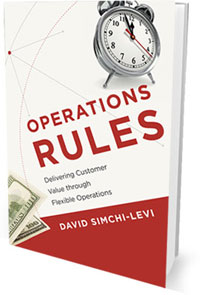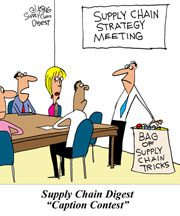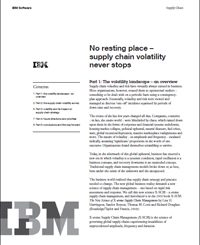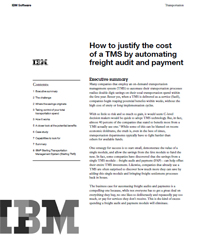 |
February 9, 2012 - Supply Chain Newsletter |
 |
This Week In SCDigest
FEATURED SPONSOR: Logility |
Download the S&OP Webcast and Whitepaper |

MODEX 2012 Full Review and Comment
|
|||||||||||||||||||||||||||
| GILMORE SAYS: |
"Cliff and I spoke with several medium-sized firms that were at MODEX with specific interest in automating (in various forms) their DCs." WHAT DO YOU SAY? |
The Cleveland show frankly had just gotten a sort of "tired" feeling in recent years, and as MHIA rightly noted was pulling from a regional basis from much the same Midwest market as ProMat (these are national shows, of course, but any event pulls heavily from the surrounding region).
So, MODEX in Atlanta was born, and it was a good move. The show floor was larger than in Cleveland, with something like 550 exhibitors. Though the crowd was light on Monday, the day after one of the most hyped Super Bowls in history, it picked up quite nicely on Tuesday, and the show had a good "buzz" to that day. It's hard to describe what that means exactly, but for show veterans like Cliff and I let's just say you know it when you feel it.
It is MHIA's goal to make MODEX into more of a supply chain show, which I guess we will say is a work in progress, as a couple of MHIA officials privately acknowledged to me. It was a fine show, but felt like a usual MHIA type event, without any change yet to more of a overall "supply chain" theme. I will note, to be clear, that includes many software exhibitors, most heavily in WMS and related supply chain execution areas. Also, to help expand the show, MHIA opened up the exhibits this year to non-MHIA members for the first time. I was told that about 160 of the booths were filled with non-MHIA members, and this will really open up the potential for future MODEX shows.
We offered extensive video coverage and comment on MODEX earlier in the week, and you can of course still see our Day 1 and Day 2 reviews, as well as a handy page that has the different topics and interesting solutions we covered as individual clips, so you can just view those that are of most interest to you - think it is worth taking a look.
As opposed to the past few MHIA shows, clear themes didn't really jump out so much to us this year, but after two long days on the show floor, a couple of things did in the end stand out.
First is just that our real sense from hardware and software vendors is that overall, things are pretty good. After a dismal 2009 and not so great 2010, 2011 was strong for many, and most vendors we spoke with seemed generally bullish about their sales "pipelines" and prospects for 2012. As just one of several examples, material handling systems company Intelligrated is building new manufacturing and headquarters space to handle its growing volumes.
The drivers of this growth: (1) as we've reported on many times, the clear focus by many companies on getting back to strong top line and unit volume growth without adding back the headcount and fixed costs they had before the recession; (2) the pressures of e-commerce not only for traditional retailers but virtually every other type of company, especially those not used to "eaches" picking; (3) an aging workforce demographic in distribution; (4) low, low interest rates; and (5) growing interest in "mid-market" type companies that typically did not much invest in automation in the past.
This last point, in fact, is its own mini-theme. Material handling automation, and to a lesser extent advanced distribution software, have traditionally not been in high demand from mid-market (say sales under $1 billion) companies. It was viewed as too expensive and too risky. But now, the same distribution pressures facing larger companies (including e-commerce) are hitting mid-sized companies too, while the equipment and especially total cost of ownership of many of these systems are coming down. That simply opens up the market to more and more companies. Cliff and I spoke with several medium-sized firms that were at MODEX with specific interest in automating (in various forms) their DCs.
The message out of all of this: while I am certainly no shill for the automation industry, if your company has been "hunkered down" since the recession, still worried about the direction of the economy (who isn't?), etc., it may be worth popping your heads up to see what some investment might do for you, because your competitors may just be moving ahead without you. I probably saw a few of them at the show.
Automated Case Picking (ACP) remained a strong theme, and Cliff and I were just blown away at the number of yet new solution providers (e.g., System Logistics, others) that we weren't familiar with until this week. The hottest action is clearly in the beverage industry, where there are now a high number of proven, working solutions, but food and grocery is not that far behind in terms of interest, as well as some nibbling and more by other sectors. More on all that very soon in our 2012 ACP Report.
We covered more than a dozen new or almost new solutions at the show that really caught our eye. Everyone of them is on the Day 1 or Day 2 videos, or can be found on the individual clips pages. I do not have room for them all here, but will highlight a few - I encourage you also to sample the individual clips. A select few of those include:
The DC simulation software from CreateaSoft: the product has been around for awhile, but was new to me, and was heavily refreshed a couple of years ago. The problem in this space has just been that it always took just too long and was too hard to build the simulation. CreateaSoft says it has solved a lot of those problems by the new way it does DC physical and process modeling, taking the time down to just 1-3 weeks. Just as interesting is the new ways the simulations are being used. Before, simulation was mostly built to test out concepts for a new DC and heavy automation. Here, examples were shown of the tool being used to test say the impact of moving to task interleaving, or understand right now why this morning throughput numbers in the DC were down today.
Savoye Retrotech showed a very intriguing new AS/RS systems that rather than using traditional cranes instead employs a high speed shuttle type system to move pallets on the outside and even within the storage structure. Had a case study of a very larger CPG company that is using the technology to load a huge number of trucks per day in one DC with not that many people, and doing so in truck stop sequence order for multi-stop retail deliveries.
Voxware announced its voice software was now available to run on the Android operating system, meaning it could be used on "consumer-ish" cell phones and tablets. But I learned you have to really certify that on each individual manufacturer's equipment - determine what type of device really makes sense in a operations environment. Motorola released a new heavily ruggedized Android tablet that was shown running RedPrairie's WMS software. This will be a very key topic over the next several years.
Out of room. Good show. Rest of the solution reviews on the video pages.
Any reaction to our MODEX review? Were you at the show? What caught your eye? Let us know your thoughts at the Feedback button below.
![]()
Supply Chain Graphic of the Week:
|
|||
CARTOON CAPTION CONTEST CONTINUES THIS WEEK!January 31, 2012 Contest
See The Full-Sized Cartoon and
|
|||
ONTARGET e-MAGAZINEWeekly On-Target Newsletter:
|
|||
|
|||
THIS WEEK ON
|
|||
WHITE PAPERS
|
|||
SUPPLY CHAIN TRIVIAContinuing on the MODEX theme, the increasingly popular concept of Motor-Driven Roller (MDR) conveyor technology, in which the rollers themselves are powered in short sections (versus a long belt-drive), was first invented to solve a problem for what government agency?Answer Found at the Bottom of the Page |
|||
Upcoming Videocast:
B2B Buyers Issue a SoMoLo Imperative

Consumers' Social, Mobile and Local Shopping Behaviors Are Now Impacting B2B Buying Cycles in a Big Way
Featuring David Bruno, Director of Commerce Studies, RedPrairie
Upcoming Videocast:
Managing Risk in a Multi-Tier Supply Chain

Look Beyond Tier One Suppliers to Lower Risk, Optimize Costs, and Enhance Resiliency
Featuring Tom Linton, SVP and CPO, Flextronics; Thomas Choi, Professor of Supply Chain Management at Arizona State University, School of Business; and Rich Becks, General Manager, High Technology, E2open
Upcoming Videocast:
Operations Rules for Driving Business Value & Growth

Part 1: Mitigating Business Risks from the Known-Unknown to the Unknown-Unknown
Featuring Prof. David Simchi-Levi of MIT
We had several letters this week on our story this week on the death of Dr. Eli Goldratt, father of the Theory of Constraints, in 2011, a story frankly we and lots of others had missed. We publish a few of them below. Feedback of the Week: On Dr. Eli Goldratt: |
||
I, too missed this news - how was it so little noted? |
||
More on Goldratt:
|
||
Thanks for catching up on Goldratt. At Niagara University, we use The Goal as a textbook supplement in the Supply Chain Management courses. It was used in the MBA section when I started teaching 10 years ago, and we even had training films featuring Eli Goldratt himself. The students found the films a bit boring and very focused on Goldratt. As one said “a little bit of him goes a long way”. Still, the value of The Goal is huge and more managers should read the book and use the concept. A Buffalo area company I do business with provides the accounting support for The Goldratt Institute so I was invited numerous times to attend programs when Goldratt was featured. The timing never seemed to work so I never did get to meet but now regret that I didn’t make time to do so. Jack Ampuja
|
||
I had the pleasure and great honor of working directly with Dr. Goldratt for the last 4 years of his life. |
||
SUPPLY CHAIN TRIVIA ANSWER
Q:Continuing on the MODEX theme, the increasingly popular concept of Motor-Driven Roller (MDR) conveyor technology, in which the rollers themselves are powered in short sections (versus a long belt-drive), was first invented to solve a problem for what government agency?
A: The United States Post Office, more than two decades ago, to solve issues related to mail trays push up off the conveyor when they were in accumulation zones.
| © SupplyChainDigest™ 2003-2011. All Rights Reserved. SupplyChainDigest PO Box 714 Springboro, Ohio 45066 |
POWERED BY: XDIMENSION |





